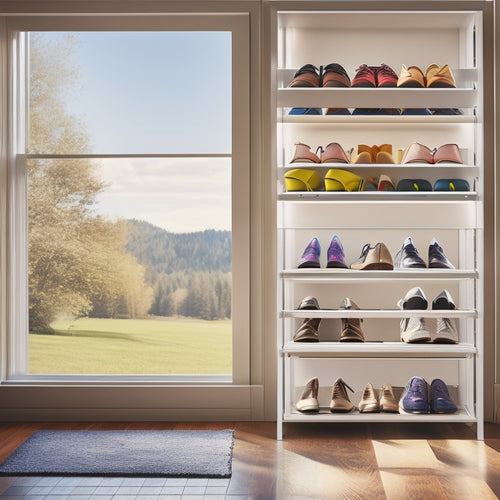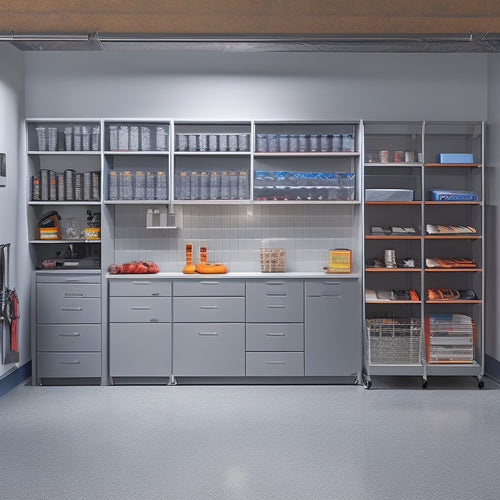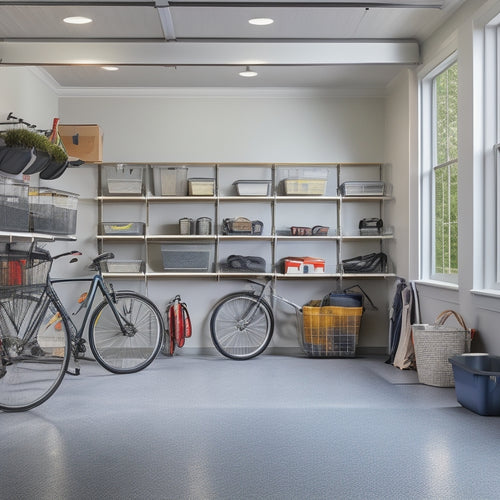
Small Storage Bins to Maximize Shelf Space
Share
When maximizing shelf space, you want to make the most of every inch. Small storage bins are the answer, but choosing the right ones can be overwhelming. Start by measuring your shelf accurately, calculating the total space, and considering obstructions. Then, select bins that fit snugly, considering item dimensions, durability, and cleaning ease. Label and organize your bins for quick identification, and stack them efficiently to maintain access. Don't forget to make use of corner shelf space and create a logical system for your bins. With the right strategies, you'll be amazed at how much you can fit - and there's more to discover.
Key Takeaways
- Measure shelf space accurately and subtract obstructions to determine usable space for bin storage.
- Select bin sizes that match item dimensions for a snug fit and consider durability needs based on stored items.
- Implement effective bin labeling with clear descriptions and color coding for quick identification and categorization.
- Stack and nest bins efficiently by selecting similar sizes, placing heavier bins at the bottom, and maintaining space between stacks.
- Utilize corner shelf space with curved bins or corner baskets to store frequently used items within easy reach.
Benefits of Maximizing Shelf Space
When it comes to organizing your storage space, maximizing shelf space is key. By doing so, you'll be able to fit more items in a smaller area, reducing clutter and creating a safer environment.
Implementing space optimization strategies will help you make the most of your shelf space, allowing you to store more items without overcrowding. This, in turn, will provide decluttering benefits, such as reducing the risk of tripping hazards and making it easier to find what you need.
Measuring Your Shelf for Bins
You're about to place small storage bins on your shelf, but first, you need to make certain they fit.
Start by measuring the shelf's length, width, and height to get the exact dimensions.
Then, calculate the available space to determine how many bins you can fit and what size they should be.
Shelf Dimensions Matter
Three key measurements will make or break your small storage bin setup: shelf width, shelf depth, and the space between shelves. These dimensions will determine the ideal bin size, guaranteeing a snug fit and maximizing storage capacity. Take out your tape measure and record these essential dimensions to avoid costly mistakes.
| Measurement | Description |
|---|---|
| Shelf Width | Distance from left to right, including any obstructions |
| Shelf Depth | Distance from front to back, including any lip or overhang |
| Space Between Shelves | Vertical clearance between shelves, facilitating easy bin retrieval |
| Shelf Height | Vertical distance from floor to shelf, influencing bin stacking |
| Shelf Material | Type of material, affecting weight capacity and durability |
Remember to take into account shelf material and weight capacity when selecting bins. Accurate measurements will guarantee a safe and efficient storage system. Don't skip this vital step – it's the foundation of a well-organized and clutter-free space.
Shelf Space Calculation
Now that you've got your shelf measurements, it's time to calculate the shelf space to determine how many bins you can fit. To do this, you'll need to take into account the shelf weight and depth.
Start by calculating the total shelf space in square inches by multiplying the shelf length and width. Next, subtract any obstructions, such as shelf supports or decorative trim, to get the usable shelf space.
Visualize your bins on the shelf, leaving about an inch of space between each bin for easy access. Divide the usable shelf space by the size of each bin to determine how many will fit.
Don't forget to take into account the shelf weight capacity when selecting bins, especially if you plan to store heavy items. Make sure the combined weight of the bins and their contents doesn't exceed the shelf's weight limit.
Measuring for Fit
With your shelf space calculation in hand, it's time to measure your shelf for the perfect fit. Take a tape measure and record the width, depth, and height of your shelf.
Don't forget to note any obstructions, such as shelf supports or electrical outlets, that may affect bin placement.
Next, consider the bin height and width you need. Think about the items you plan to store and choose bins that will accommodate them comfortably.
Be certain to leave some space between bins for easy access and to prevent overcrowding.
When measuring, visualize how the bins will fit on the shelf. Will they sit side by side or stacked on top of each other?
Consider the shelf's weight capacity and the combined weight of the bins and their contents. Measure carefully to guarantee a safe and efficient storage solution.
Selecting the Right Bin Size
You'll need a bin that's proportional to the items you're storing, so consider their size, shape, and quantity when selecting the right bin size. This guarantees a snug fit, prevents clutter, and maximizes shelf space.
Bin depth considerations are essential, as you want to verify the items fit comfortably without overflowing or getting stuck. Shallow bins are ideal for small, flat items like paper or office supplies, while deeper bins are better suited for bulky items like toys or linens.
Bin shape variety is also important. Rectangular bins are great for storing long, thin items like books or cleaning supplies, while square bins are better for storing cube-shaped items like boxes or containers.
Consider the shape of the items you're storing and choose a bin that complements them. By selecting the right bin size, you'll be able to store more efficiently, reduce clutter, and create a safer, more organized storage space.
Choosing the Best Bin Material
The right bin material can make all the difference in maintaining a clean, organized, and functional storage space. When choosing the best bin material, you'll likely come across two popular options: plastic and fabric.
Plastic bins are ideal for storing items that require extra protection from moisture or pests. They're also easy to clean and can withstand heavy use. However, they can crack or break if dropped, and may not be as aesthetically pleasing as fabric bins.
On the other hand, fabric bins are a great choice for storing soft or lightweight items, like clothing or toys. They're often collapsible, making them easy to store when not in use, and can add a touch of style to your storage space. However, they may not be as durable as plastic bins and can be prone to tears or punctures.
When deciding between plastic and fabric, consider the items you'll be storing and the level of durability you need. Regardless of which material you choose, look for bins with sturdy construction and reinforced seams to guarantee they can withstand regular use.
Labeling and Organizing Bins
You've got your small storage bins, now it's time to make them work efficiently for you.
By implementing effective bin labeling strategies, you'll be able to quickly identify what's inside each bin, saving you time and frustration.
Clear storage signage will also help you maintain a sense of order and keep your storage space organized.
Bin Labeling Strategies
Frequently, a well-organized storage system relies on one essential element: clearly labeled bins.
You've carefully selected the perfect bins for your storage needs, but without labels, they're just empty containers. Effective labeling helps you quickly identify what's inside, making it easier to find what you need and preventing accidents caused by mistaken contents.
To create a labeling system that works for you, consider the following strategies:
-
Color coding: Use different colored labels or stickers to categorize bins by type, such as red for hazardous materials or green for cleaning supplies.
-
Bin shapes: Match label shapes to bin shapes, making it easy to recognize which label corresponds to which bin.
-
Clear descriptions: Write concise, descriptive labels that indicate exactly what's inside the bin, like "Paintbrushes" or "Safety Goggles".
- Symbols and icons: Use visual symbols or icons to supplement text labels, especially for bins containing hazardous materials or requiring special handling.
Clear Storage Signage
Labeling individual bins is just the starting point. To take your storage organization to the next level, you need clear storage signage that effectively communicates what's inside each bin. This is where clear signage advantages come into play.
With clear signage, you can quickly identify what's inside each bin, reducing the time spent searching for items and minimizing the risk of accidents caused by mistaken identities.
To create effective labeling techniques, use a consistent font and color scheme throughout your storage area. This will help create a visual hierarchy, making it easier to scan and identify bins.
Consider using images or icons to supplement text labels, especially for bins containing hazardous materials or equipment. This will guarantee that even those who don't speak the dominant language in your workplace can understand the contents.
Stacking and Nesting Bins Efficiently
With your storage bins in hand, it's time to maximize their potential by stacking and nesting them efficiently. Proper stacking and nesting techniques can help you make the most of your shelf space while keeping your storage area organized and safe.
To guarantee you're stacking and nesting like a pro, follow these tips:
-
Choose the right size: Select bins that are similar in size to create a stable stack. This will prevent smaller bins from getting lost or crushed.
-
Stack heavy to light: Place heavier bins at the bottom and lighter ones on top to prevent the stack from toppling over.
-
Nest similar shapes: Nest bins with similar shapes to maximize storage capacity and reduce empty space.
- Leave space to breathe: Don't overcrowd your shelves. Leave a little space between stacks for easy access and to prevent bins from getting stuck.
Utilizing Corner Shelf Space
Now that you've perfected the art of stacking and nesting small storage bins, it's time to tackle the often-wasted space in the corners of your shelves. These areas can be notoriously difficult to employ, but with the right corner shelf ideas, you can maximize corners and create a more organized and efficient storage system.
Start by evaluating the dimensions of your corner shelves and the types of items you need to store. Consider using corner baskets or bins specifically designed to fit snugly into these spaces. These can be used to store items like cleaning supplies, linens, or kitchen utensils, keeping them within easy reach while keeping the floor clear.
To further maximize corners, look for bins with curved or angled shapes that can fit comfortably into the corner space. You can also use stackable bins with a small footprint to create a compact storage tower.
Creating a Bin Organization System
Three key elements form the foundation of an effective bin organization system: categorization, accessibility, and visibility.
You'll want to group similar items together, make certain bins are easy to reach, and confirm the contents are visible at a glance. This trifecta will help you maximize your shelf space and reduce clutter.
To create a seamless bin organization system, consider the following tips:
- Use bin color coordination to categorize items by theme, such as blue bins for cleaning supplies and green bins for gardening tools.
- Label each bin clearly, so you can quickly identify what's inside.
- Place bins in a logical order, with frequently used items in easy-to-reach locations.
- Keep bins off the floor to prevent water damage and pest infestations.
Popular Small Storage Bin Options
You're spoiled for choice when it comes to small storage bins, and the right one can make all the difference in maintaining your newly organized space. From decorative storage options that add a touch of style to your shelves to eco-friendly choices that align with your values, there's a bin to fit your needs.
| Bin Type | Description |
|---|---|
| Multi-Functional | Bins that serve multiple purposes, such as storage and seating |
| Collapsible | Bins that can be easily folded and stored when not in use |
| Color Coded | Bins that can be customized with different colors to categorize items |
| Themed | Bins that match a specific theme or decor, such as seasonal or holiday-themed |
When selecting a bin, consider factors like durability, budget, and space constraints. Look for bins made from durable materials that can withstand frequent use. If you're on a tight budget, opt for budget-friendly choices that still offer great functionality. Finally, consider bins with space-saving designs that can maximize your shelf space. With so many options available, you're sure to find the perfect bin to keep your space organized and clutter-free.
Frequently Asked Questions
Can I Use Small Storage Bins for Items Other Than Shelf Storage?
You can think outside the shelf to find creative uses for small storage bins, like corralling cords, storing craft supplies, or organizing desk drawers - with these clever organizing tips, you'll uncover a world of possibilities!
Are Small Storage Bins Suitable for Humid or Damp Environments?
When storing items in humid or damp environments, you'll want to guarantee your bins are moisture-resistant and have adequate ventilation options to prevent mold and mildew growth, keeping your belongings safe and dry.
Can I Customize Small Storage Bins to Fit My Specific Needs?
You can tailor storage solutions to your unique needs with custom designs that blend functional aesthetics, ensuring your space is both organized and visually appealing, while prioritizing safety in every detail.
Are Small Storage Bins Safe for Storing Heavy or Fragile Items?
You might worry that small storage bins won't hold up, but don't stress! Look for bins with clear weight capacity labels. For fragile materials, choose bins with cushioning or dividers to prevent breakage, ensuring your items stay safe and secure.
Can I Use Small Storage Bins in Areas With High Foot Traffic?
When placing storage solutions in areas with high foot traffic, you'll want to guarantee they're secure and won't tip over. Look for bins with sturdy bases and weights that can withstand constant movement, keeping your belongings and passersby safe.
Conclusion
You've done it! You've changed your shelf from a cluttered catastrophe to a masterpiece of organization. With your newfound skills, you can fit an astonishing amount of stuff into teeny-tiny spaces, making you the ultimate storage ninja! Your friends will gasp in awe, wondering how you managed to cram so much into so little. Your shelves will be the envy of the neighborhood, and you'll be the most organized person on the block!
Related Posts
-

Adjustable Modular Shoe Racks for Versatility
Adjustable modular shoe racks are your go-to solution for versatile and organized footwear storage. These racks maxim...
-

Building a Garage Storage System With Built-Ins
You're about to build a garage storage system with built-ins that fits your unique needs, starting by evaluating your...
-

Bin Garage Storage Ideas for Maximizing Space
You can greatly maximize your garage's storage space by utilizing vertical space with ceiling storage bins, stacking ...


